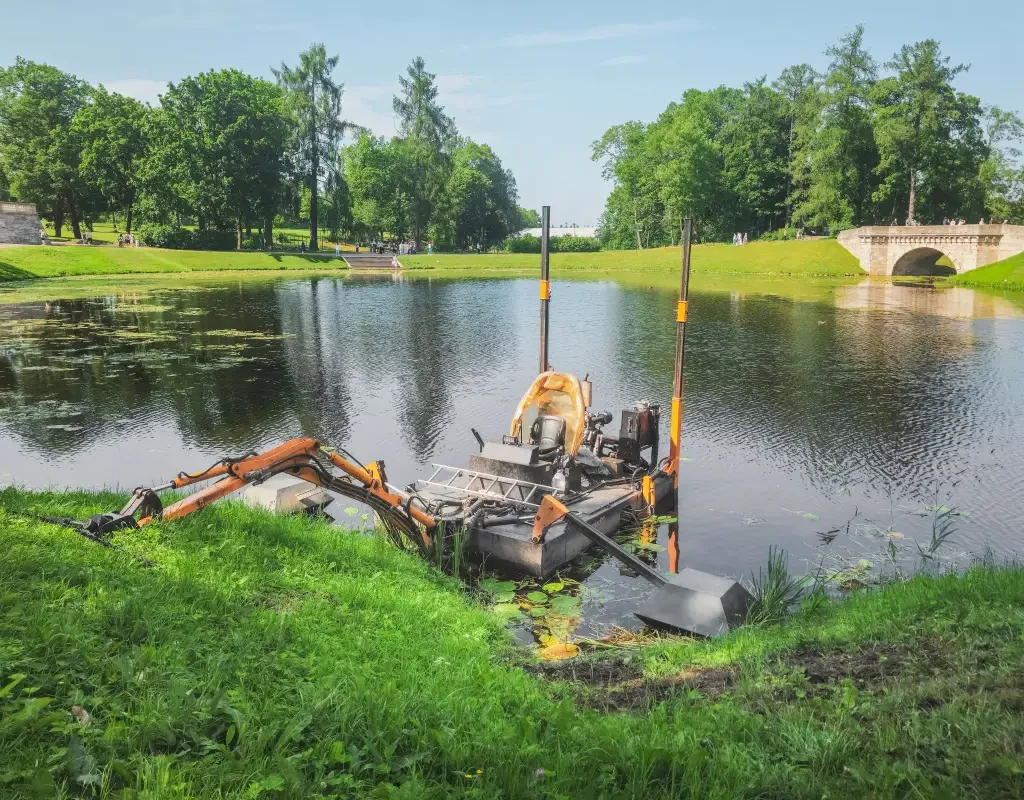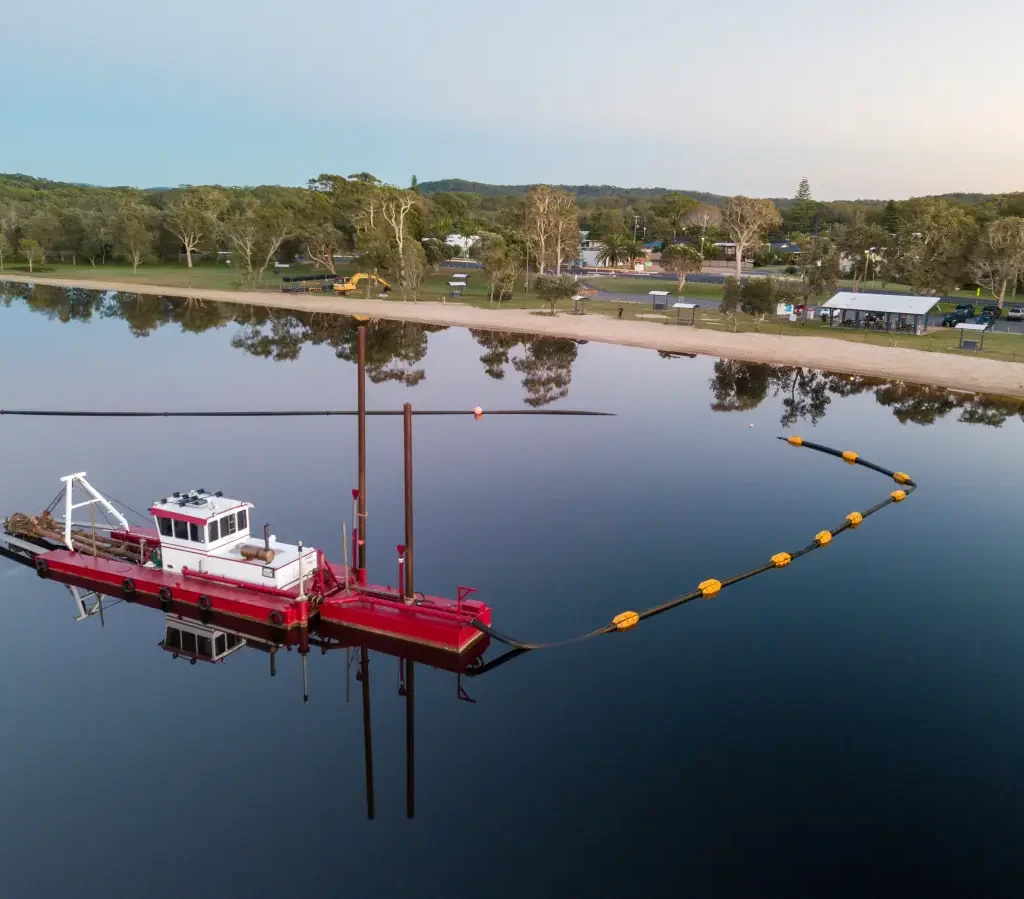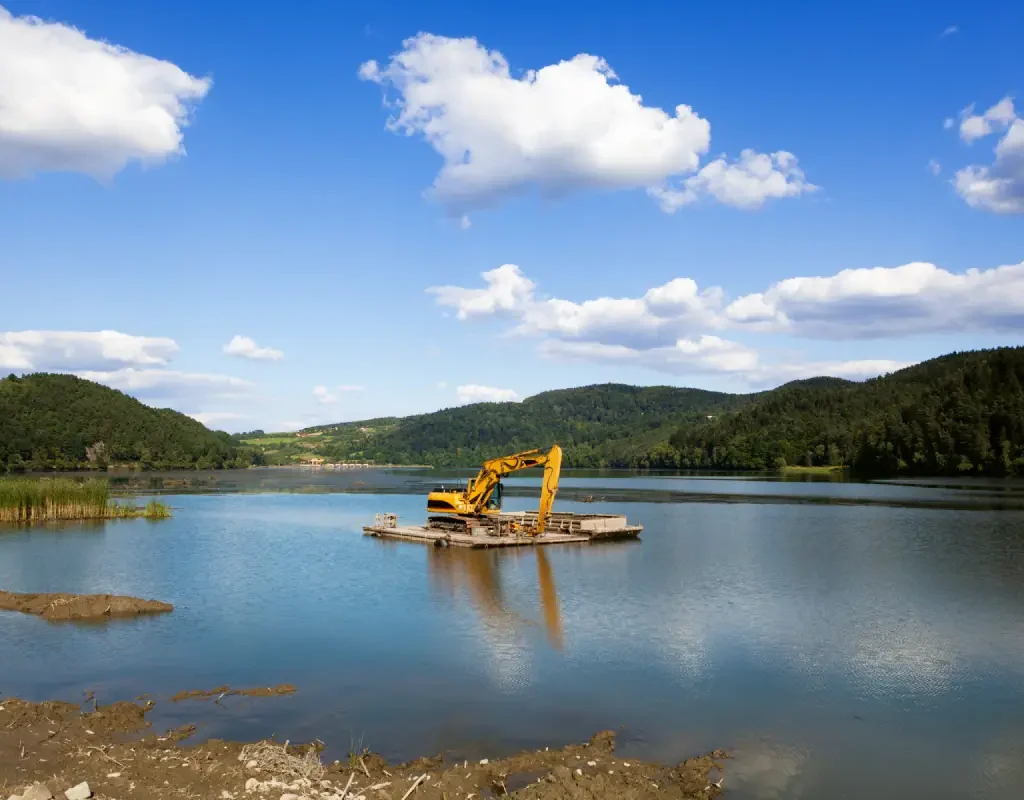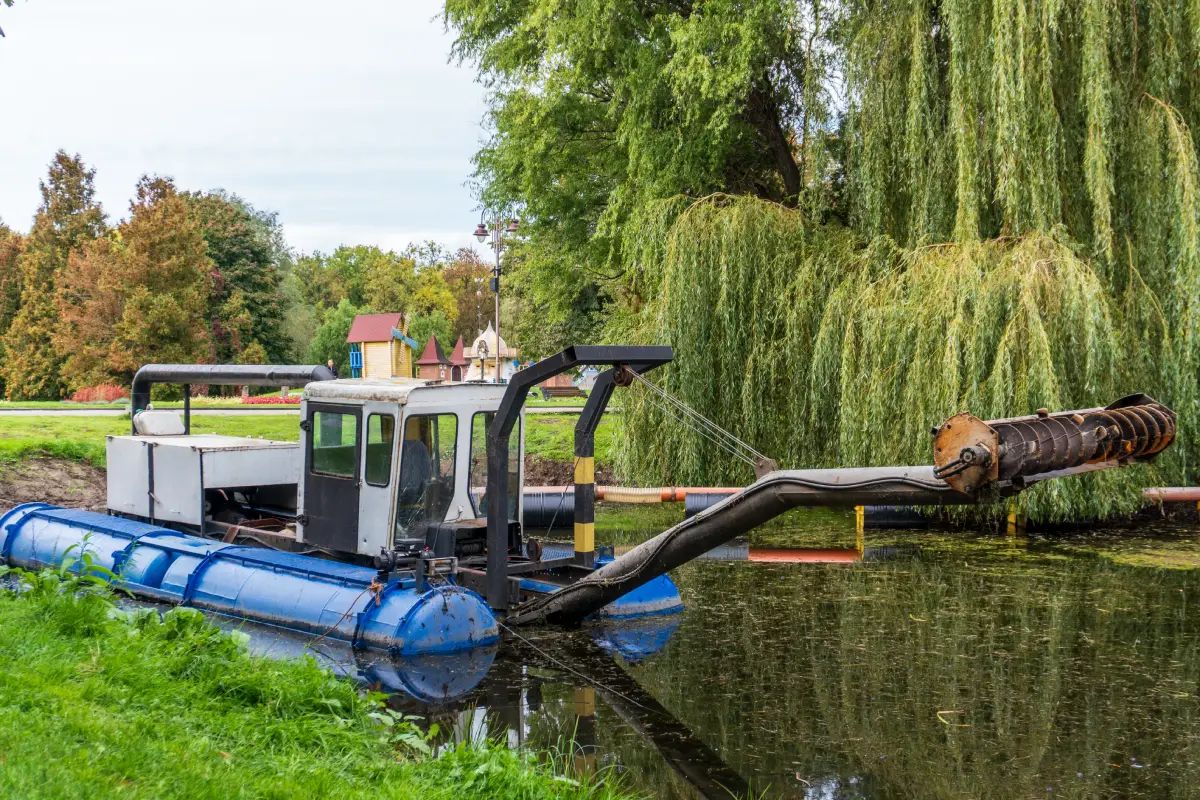Introduction: Why Dredging a Lake Matters
Dredging a lake is one of the most effective and sustainable methods for restoring water quality and ecological balance in degraded freshwater systems. Lakes are vital natural assets that provide clean water, support recreation, and sustain habitats for aquatic and terrestrial species. However, decades of sedimentation, nutrient inflow, and pollution have gradually reduced their depth, clarity, and oxygen levels. As these conditions worsen, ecosystems become dominated by algae and decaying organic matter—a process known as eutrophication.
Removing accumulated sediment, organic debris, and pollutants through lake dredging restores natural depth and circulation, improves oxygen exchange, and reduces nutrient concentrations. The process also enhances flood control, stabilizes shorelines, and creates a healthier environment for aquatic life.
For engineers, environmental planners, and water management authorities, understanding the principles and long-term value of lake dredging is critical. Modern projects integrate hydrological modeling, sediment analysis, and precise dredging equipment to balance technical performance with environmental protection. When designed and executed correctly, dredging operations transform stagnant, silt-filled water bodies into resilient ecosystems that can sustain biodiversity, protect local communities, and deliver measurable improvements in water quality for generations.
Understanding the Process of Lake Dredging
At its core, lake dredging is the controlled removal of accumulated sediment, sludge, and debris from a lakebed using specialized mechanical or hydraulic equipment. Over time, lakes naturally collect organic matter, sand, silt, and clay through runoff, erosion, and decaying vegetation. As these layers thicken, they trap nutrients, heavy metals, and contaminants, disrupting circulation and creating anaerobic zones that reduce dissolved oxygen and threaten aquatic life.
A dredge for lake restoration is specifically engineered to excavate this material while minimizing ecological disturbance. The method selected depends on sediment type, depth, hydrology, and the sensitivity of surrounding habitats. Each dredging approach has distinct advantages suited to specific environmental and operational requirements:
- Hydraulic Dredging: Uses high-capacity suction pumps to vacuum sediment and water as a slurry, transporting it through floating pipelines to dewatering or containment sites. It is efficient for soft, fine materials and large-scale restoration projects.
- Mechanical Dredging: Utilizes clamshell buckets, draglines, or excavators mounted on barges to lift sediment from the bottom physically—ideal for compacted or coarse material and confined locations.
- Cutter Suction Dredging: Combines rotating cutterheads with suction pipes to break up dense or cohesive deposits before removal, enabling precise depth control.
Selecting the right dredge for lake operations requires detailed site assessment, sediment sampling, and hydraulic modeling. Factors such as sediment density, contamination levels, and water depth influence design decisions. By integrating advanced surveying technology, turbidity controls, and eco-friendly dredge systems, modern lake dredging achieves both engineering efficiency and environmental compliance—restoring natural depth, water quality, and ecological function for the long term.

Causes of Sediment Buildup and Water Degradation
Before dredging a lake, it is essential to understand why lakes gradually lose depth, clarity, and biological balance. The primary factor is sediment loading—the continuous inflow of fine particles such as silt, clay, and decomposed organic matter from the surrounding watershed. Activities like agriculture, deforestation, and construction disturb soils, allowing stormwater runoff to carry sediment and nutrients directly into the lake. Over time, these deposits settle to the bottom, reducing water storage capacity and altering the ecosystem’s physical and chemical characteristics.
Each rainfall event contributes new material, often laden with nitrogen and phosphorus from fertilizers or urban pollutants. These nutrients become trapped within the sediment layer, fueling excessive algal growth and reducing oxygen levels. As decomposition accelerates, anaerobic conditions form, producing hydrogen sulfide and methane gases that further stress aquatic life and lead to fish mortality.
In urban catchments, impermeable surfaces such as pavement and rooftops amplify runoff velocity, accelerating erosion and sediment transport. Without proactive management, this feedback loop makes the lake shallower, limits sunlight penetration, and allows algae to outcompete native submerged plants.
Ultimately, this progressive decline highlights why dredging a lake is not merely an aesthetic improvement but a technical necessity. Removing the accumulated sediment through lake dredging restores depth, improves water quality, and re-establishes ecological stability—ensuring that the lake remains a functional and sustainable component of the watershed for years to come.
Key Environmental and Water Quality Benefits of Dredging a Lake
The benefits of dredging a lake extend far beyond restoring physical depth. Each dredging operation contributes to multiple environmental and engineering objectives:
Improved Water Quality
By removing nutrient-rich sediments, lake dredging directly reduces phosphorus and nitrogen concentrations. These are the primary drivers of eutrophication and algal bloom formation. Lower nutrient levels help restore water clarity and maintain stable oxygen levels.
Enhanced Hydraulic Capacity
Sediment removal increases storage volume, improving flood control and reducing the risk of overflow during storm events. This is critical for lakes that serve as stormwater retention basins.
Algae and Odor Mitigation
By removing decaying organic layers, dredging minimizes conditions that favor cyanobacteria and reduces the release of foul-smelling gases such as hydrogen sulfide.
Habitat Restoration
Dredging a lake reestablishes balanced substrates suitable for fish spawning and aquatic vegetation. The improved light penetration encourages healthy plant growth, stabilizing the lakebed.
Erosion Prevention
Restored depth and circulation patterns reduce shoreline erosion, protecting adjacent property and infrastructure.
Each of these outcomes demonstrates how a targeted dredge for lake operation supports both ecological and civil engineering objectives simultaneously.

How Dredging Restores Aquatic Ecosystem Health
From an ecological perspective, the relationship between dredging a lake and ecosystem restoration is deeply intertwined. Sediment-laden lakes often experience biological stagnation, in which excess nutrients trigger explosive algal growth and collapse native biodiversity.
A properly planned lake dredging project reverses these dynamics. By removing the upper layer of nutrient-rich muck, engineers reset the system’s biological baseline. Dissolved oxygen increases as anaerobic zones diminish, supporting fish and invertebrate populations. In addition, clearer water allows sunlight to reach greater depths, enabling submerged macrophytes to photosynthesize and stabilize sediment.
A dredge for lake health isn’t just an engineering project—it’s a biological intervention. It allows a lake’s self-purification processes to resume naturally. Over time, rebalanced nutrient cycling and oxygenation enhance the resilience of the aquatic ecosystem against future disturbances.
The Role of Modern Dredging Equipment in Sustainable Lake Management
Technological innovation has transformed how engineers approach dredging a lake. Modern dredges integrate automation, GPS-guided navigation, and real-time depth monitoring to improve accuracy and protect the environment.
A hydraulic dredge for lake restoration today can operate with centimeter-level precision, minimizing turbidity and avoiding over-excavation. Remote-controlled units and amphibious dredgers can access shallow or ecologically sensitive zones that were once unreachable.
Moreover, equipment manufacturers have developed advanced dewatering systems to responsibly handle dredged material. Geotextile tubes, polymer conditioning, and silt curtains ensure that lake dredging operations maintain compliance with water-quality standards and minimize downstream sediment plumes.
The transition toward cleaner, more energy-efficient pumps and electric power options has also reduced emissions, making lake dredging an increasingly sustainable practice aligned with modern environmental policies.
Dredging a Lake: Steps, Techniques, and Best Practices
The success of any lake dredging project depends on systematic planning and execution. The process typically follows several key phases:
1. Assessment and Surveying
Bathymetric mapping and sediment sampling establish baseline data. Engineers evaluate depth contours, sediment layers, and contamination levels to determine project scope.
2. Design and Permitting
A site-specific design is developed, including dredging methods, equipment selection, and sediment management strategy. Regulatory approval is obtained from environmental authorities, ensuring that dredging a lake complies with applicable standards.
3. Mobilization and Execution
The selected dredge for lake operations is deployed. Hydraulic dredges pump slurry through floating pipelines to designated containment areas. Mechanical dredges may be used in confined or shallow regions.
4. Sediment Dewatering and Disposal
Material removed during lake dredging is processed using geotextile tubes, settling basins, or filter presses to separate solids from water. The dried sediment can be reused for soil improvement or land reclamation, or disposed of at approved sites.
5. Post-Dredging Monitoring
After completion, water samples are analyzed for clarity, turbidity, and nutrient concentrations. Periodic inspections verify that the ecosystem is recovering as expected.
By following these stages with precision, engineers ensure that dredging a lake achieves its environmental and hydraulic objectives while maintaining regulatory integrity.

Challenges and Environmental Considerations in Lake Dredging
Despite its benefits, lake dredging poses certain challenges that require technical foresight. The first involves sediment management—handling large volumes of material without causing secondary pollution. Inadequate disposal planning can lead to re-suspension of contaminants, negating much of the dredging’s benefit.
Another concern is ecological disturbance. Fish spawning grounds, aquatic vegetation, and benthic organisms must be protected through seasonal scheduling and the use of sediment curtains. Regulatory agencies often restrict dredging in a lake during sensitive breeding months.
Noise, turbidity, and fuel emissions are additional operational issues. Modern low-impact dredges mitigate these effects through efficient hydraulic systems, electric motors, and precision control.
Lastly, project economics play a role. Lake dredging can be capital-intensive, but long-term cost analyses consistently show that maintaining depth and water quality through periodic dredging prevents far greater costs associated with ecosystem collapse, flood damage, or potable water degradation.
Careful engineering design ensures that each dredge for a lake project balances environmental protection with financial feasibility.
Long-Term Maintenance and Monitoring After Dredging
Dredging a lake is not a one-time event—it marks the beginning of a continuous, adaptive water management strategy. Even the most thorough dredging efforts will eventually be affected by the natural process of sediment reaccumulation. Without an established maintenance framework, sedimentation can return within a few years, diminishing the depth and clarity that the project originally restored.
Post-dredging monitoring serves as an early warning system for future issues. Engineers and environmental specialists routinely track parameters such as turbidity, nutrient concentration, dissolved oxygen, and sediment inflow. Bathymetric surveys conducted every three to five years can map depth changes and pinpoint areas where material begins to accumulate again. By integrating this data into maintenance planning, managers can schedule targeted interventions before widespread degradation occurs.
Inlets, culverts, and storm drains feeding the lake should be fitted with silt traps and vegetative buffers to intercept sediment and nutrients at the source. Combining these measures with upland erosion control and runoff management significantly extends the lifespan of lake dredging efforts. Additionally, shoreline stabilization through native vegetation helps prevent soil loss and sediment inflow during storm events.
A comprehensive maintenance plan ensures that the benefits of dredging a lake—including improved water quality, greater depth, and revived aquatic habitats—remain intact for decades. Modern engineering firms often design adaptive management frameworks that allow limited re-dredging in problem zones, using smaller, less invasive equipment to maintain optimal conditions.
When viewed as an ongoing cycle rather than a single operation, a lake dredging program becomes a model of proactive stewardship. Communities that invest in continuous maintenance not only preserve ecological integrity but also protect their long-term economic and environmental investments.

Why Partnering with Professional Lake Dredging Contractors Matters
Executing a lake dredging project demands more than equipment—it requires multidisciplinary expertise. Engineers, environmental scientists, and operators must coordinate to meet hydrological, ecological, and regulatory objectives.
Professional dredging contractors possess the technical capability to assess sediment profiles, design efficient removal systems, and operate specialized machinery safely. They also manage logistics, permitting, and sediment reuse or disposal in compliance with state and federal standards.
Partnering with an experienced lake-dredging provider ensures minimal environmental impact, optimized project timelines, and predictable cost structures. Contractors with proven track records understand the nuances of dredging a lake across varying conditions—from small residential lakes to large municipal reservoirs.
Whether the goal is to restore recreational use, enhance stormwater storage, or rehabilitate aquatic ecosystems, expert guidance ensures the lake’s long-term sustainability.
Conclusion: Keeping Lakes Healthy Through Responsible Dredging
Healthy lakes reflect responsible stewardship. Over time, sedimentation, nutrient loading, and pollution threaten these vital ecosystems—but through engineered intervention, the damage can be reversed.
Dredging a lake restores depth, enhances water quality, and revives the ecological processes that sustain life. It is one of the most effective tools available for long-term aquatic rehabilitation.
For communities and agencies seeking professional support in lake dredging, working with an experienced team ensures precise execution, environmental compliance, and sustainable results. Bama Dredge stands at the forefront of comprehensive dredging solutions, combining advanced technology with proven environmental expertise.
With proactive lake dredging programs, lakes can remain functional, resilient, and ecologically balanced for generations to come.
Frequently Asked Questions
1. How often should a lake be dredged?
The frequency depends on sedimentation rates, watershed conditions, and lake usage. On average, most systems benefit from dredging a lake every 15–25 years, with smaller maintenance cycles in between.
2. What are the signs that a lake needs dredging?
Reduced depth, persistent algae blooms, poor water clarity, and strong odors are key indicators that lake dredging may be necessary.
3. Is dredging harmful to fish or aquatic life?
When performed by trained professionals with environmental safeguards in place, dredging a lake can actually improve aquatic habitats by restoring oxygen levels and reducing harmful sediment.
4. What happens to the removed sediment?
Material collected during lake dredging is typically dewatered, tested, and either reused for land applications or disposed of in licensed facilities.
5. How long does a typical dredging project take?
Project duration varies with lake size and sediment volume, but most dredge for lake operations range from several weeks to a few months, depending on site conditions and regulatory approvals.

